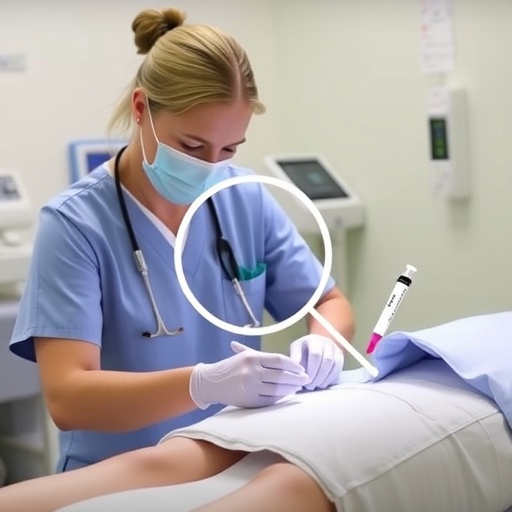In the ever-evolving landscape of nursing education, the integration of innovative teaching technologies has become paramount. Recent research led by Yıldızbaş and Turan unveiled the compelling impact of video-assisted instruction on nursing students’ competencies, particularly in administering ventrogluteal intramuscular injections. This landmark study, published in “BMC Nursing,” underscores a paradigm shift in pedagogical methodologies, aiming to enhance the clinical skills of future nurses. The significance of such advancements cannot be overstated, especially in light of the increasing complexity of patient care requirements.
Video-assisted instruction, a modern educational tool, leverages visual learning to reinforce theoretical knowledge through practical demonstrations. The study involved a control group and an experimental group, where the latter experienced a tailored video tutorial designed to illustrate the correct techniques for ventrogluteal intramuscular injections. The researchers meticulously assessed the outcomes by evaluating the skills showcased by both groups post-instruction, ensuring a comprehensive understanding of the instructional methods’ efficacy.
The study revealed that students who underwent video-assisted training exhibited a substantial improvement in their practical competencies compared to their peers who received traditional instruction. The meticulously designed video not only clarified the procedural steps but also addressed common pitfalls that nursing students may encounter during injection administration. This aspect of the training emphasizes the importance of visual aids in reinforcing learning outcomes, which can often be challenging in a purely theoretical framework.
Furthermore, the results hinted at the potential for broader applications of video-assisted instruction across various nursing competencies beyond just injection techniques. This capability to adapt the instructional content to cater to diverse skills sets a solid foundation for a more dynamic nursing curriculum. Educational stakeholders must take cognizance of these findings and consider the integration of similar instructional videos as standard practice in nursing programs globally.
The implications of this research extend beyond the immediate educational setting; they resonate within the clinical environments where future nurses will be practicing. Enhanced injection skills not only bolster a nurse’s confidence but also improve patient safety and care quality. Proper administration techniques can significantly reduce the risks associated with intramuscular injections, such as infection or incorrect medication delivery, ultimately contributing to better patient outcomes.
Moreover, this study compels educators to reflect upon their teaching strategies, advocating for the adoption of technology in nursing education. Integration of digital platforms such as video tutorials aligns with today’s learning preferences, particularly among millennial and Generation Z students who are accustomed to visual and interactive content. As these cohorts become the primary demographic in nursing programs, failing to adapt could create educational gaps that jeopardize future healthcare standards.
As the nursing profession continues to grapple with workforce shortages and increased healthcare demands, optimizing educational outcomes is more crucial than ever. The findings from Yıldızbaş and Turan’s research lend credence to the argument for innovative teaching methods that align with contemporary educational practices. The adoption of video-assisted instruction could serve as a pivotal strategy in preparing competent healthcare professionals equipped to face the challenges of modern healthcare settings.
Nursing educators and institutions are encouraged to further investigate the incorporation of video-assisted instructional tools. Future research may explore the long-term retention of skills acquired through such methodologies and how these can translate into real-world clinical competence. The educational model may evolve to not only include video demonstrations but also interactive simulations that further immerse students in realistic scenarios.
The study also raises questions regarding the scalability of video-assisted training programs. Educational institutions must consider aspects such as resource allocation, faculty training, and curriculum integration to effectively implement these instructional improvements. A collaborative approach involving faculty, technical experts, and nursing students could facilitate a smoother transition towards a more technologically integrated nursing education landscape.
As we navigate through the complexities of healthcare education, it is essential to critically assess and refine our instructional methods. The innovative trends heralded by this research present an exciting opportunity for nursing academies worldwide to revolutionize their teaching paradigms. Embracing technology is not merely an enhancement of the curriculum; it is a necessary evolution in response to the changing dynamics of healthcare education.
In conclusion, the work of Yıldızbaş and Turan emphasizes the significant potential of video-assisted instruction in nursing education. By bridging the gap between theory and practice, these methodologies foster a more competent and confident nursing workforce. As healthcare challenges continue to surge, prioritizing innovative and effective educational approaches will be vital in equipping nursing students with the skills they need to excel in their future careers, ultimately ensuring optimal care for patients around the globe.
The future of nursing education is clearly on a progressive trajectory, driven by the needs of both learners and the ever-changing landscape of healthcare. By leveraging advancements in technology, educators can provide enhanced instructional experiences that not only meet educational standards but also equip students with practical skills essential for successful nursing practice.
As research like that of Yıldızbaş and Turan informs and inspires nursing programs, it encourages an ongoing commitment to excellence and innovation in teaching, ensuring that future nurses are well-prepared to meet the health needs of the populations they serve.
Subject of Research: The effect of video-assisted instruction on nursing students’ skills in administering ventrogluteal intramuscular injections.
Article Title: The effect of video-assisted instruction on nursing students’ skills in administering ventrogluteal intramuscular injections.
Article References: Yıldızbaş, D., Turan, N. The effect of video-assisted instruction on nursing students’ skills in administering ventrogluteal intramuscular injections. BMC Nurs 24, 1428 (2025). https://doi.org/10.1186/s12912-025-04076-8
Image Credits: AI Generated
DOI: https://doi.org/10.1186/s12912-025-04076-8
Keywords: nursing education, video-assisted instruction, intramuscular injections, nursing skills, educational technology, practical training.




